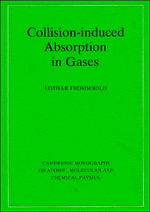6 - Theory: molecular gases
Published online by Cambridge University Press: 23 September 2009
Summary
In Chapter 5 the absorption spectra of complexes of interacting atoms were considered. If some or all of the interacting members of a complex are molecular, additional degrees of freedom exist and may be excited in the presence of radiation. As a result, besides the translational profiles discussed in Chapter 5, new spectral bands appear at the rotovibrational transition frequencies of the molecules involved, and at sums and differences of such frequencies – even if the non-interacting molecules are infrared inactive. The theory of absorption by small complexes involving molecules is considered in the present Chapter.
We will be concerned with the spectral bands in the microwave and infrared regions. The translational and the purely rotational bands appear both at low frequencies and form in general one composite band, especially at the higher temperatures where individual lines tend to overlap (‘rototranslational band’). Moreover, various rotovibrational bands in the near infrared will be considered, such as the fundamental and the overtone bands. Even high overtone bands in the visible are of interest, e.g., of H2. We have seen in Chapter 3 that induced spectra of the kind are readily discernible in gases whose (non-interacting) molecules are infrared inactive, but evidence exists that suggests the presence of induced absorption in the allowed molecular bands as well. Induced absorption involving electronic transitions will be briefly considered in Chapter 7.
- Type
- Chapter
- Information
- Collision-induced Absorption in Gases , pp. 279 - 355Publisher: Cambridge University PressPrint publication year: 1994

